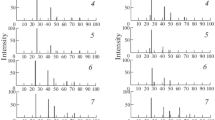Abstract
The range of stoichiometry and defect structure of chromium sesquisulphide, “Cr2S3”, have been determined for a range of temperature (1123 to 1273 K) and sulphur pressure (1.06×10−1 to 1.77×104 N m−2) employing chemical analysis, marker and thermoelectric power measurement techniques. It has been shown that the upper limit of stoichiometry corresponds to CrS1.54, while the lower limit extends to at least CrS1.30. The conditions (temperature and sulphur pressure) under which the compound is stable at compositions intermediate to these values have been determined for S/Cr ratios at intervals of 0.02.
It has been established that “Cr2S3” is ann-type metal-excess compound within these composition limits, containing unassociated trivalent chromium interstitials and/or trivalent chromium interstitials associated with one quasi-free electron, as the predominant mobile defect species.
Similar content being viewed by others
References
K. N. Strafford,Met. Rev. no. 138,Metals and Materials 3 (1969) 153.
P. A. Bergman,Corrosion 23 (1967) 72.
R. Viswanathan,ibid 24 (1968) 359.
E. J. Bradbury andP. Hancock,Metallurgia 67 (1963) 3.
T. Geiger andM. Semitsch, Sulzer Tech. Rev. (Switzerland), 1968, No. 1968, p. 31.
G. J. Danek, Jun,Naval Engineers Journal, Dec. 1965, p. 859.
H. H. Uhlig, “Corrosion and Corrosion Control” (Wiley, New York, 1965) p. 172.
P. Hancock, in “First International Congress on Metallic Corrosion” (edited by L. Kenworthy) (Butterworths, London, 1962) p. 193.
A. U. Seybolt andA. Beltran,ibid in “ p. 21.
A. Davin andD. Coutsouradis,Cobalt,No. 17 (1962) 1.
S. Mrowec, T. Werber, andM. Zastawnik,Corrosion Sci. 6 (1966) 47.
A. U. Seybolt,Trans. Met. Soc. AIME 242 (1968) 1955.
S. Mrowec,Bull. Acad. Polon. Sci. Ser. Chim. 13 (1965) 27.
M. Kaufman,Trans. ASM 62 (1969) 591.
K. N. Strafford andA. F. Hampton,J. Less-Common Metals 21 (1970) 305.
L. V. Azaroff andJ. J. Brophy, “Electrical Processes in Materials” (McGraw-Hill, New York, 1963) p. 233.
K. N. Strafford andR. Manifold,Corrosion Sci. 9 (1969) 489.
K. N. Strafford andA. F. Hampton,J. Less-Common Metals 25 (1971) 435.
A. U. Seybolt (General Electric R. and D. Centre, Schenectady, New York), private communication 1968.
A. I. Vogel, “Quantitative Inorganic Analysis” (Longmans, London, 1964) p. 311.
J. P. Hager andJ. F. Elliott (1967)Trans. Met. Soc. AIME 239 (1967) 513.
M. J. Moroney, “Facts from Figures” (Penguin, London, 1962) p. 286.
R. R. Heikes andR. W. Ure, “Thermoelectricity” (Interscience, New York, 1961) p. 313.
K. N. Strafford andA. F. Hampton,Nature (Physical Science) 232 (1971) 90.
O. Kubaschewski andB. E. Hopkins, “Oxidation of Metals and Alloys”, 2nd Edn. (Butterworths, London, 1962) p. 24.
W. B. Hannay (Ed) “Semiconductors” (Rheinhold, New York, 1959) p. 42.
J. Benard andY. Jeannin,Adv. Chem. Series 39 (1963) 191.
C. De Ranter andR. Breakpot,Bull. Soc. Chim. Belges. 78 (1961) 503.
K. Hauffe, “Oxidation of Metals” (Plenum Press, New York, 1965) p. 366.
O. Kubaschewski andO. Von Goldbeck,Metalloberflache 8 (1954) Series A, 33.
S. V. Radzkovskaya andKh. Oganesyan,Arom. Khim. Sh. 19 (1966) 844.
K. N. Strafford, Pd.D. Thesis University of Manchester, 1965.
I. A. Menzies andK. N. Strafford,J. Less-Common Metals 12 (1967) 85.
Idem, Corrosion Sci.,7 (1967) 23.
R. B. Dooley andJ. Stringer,Corrosion Sci. 10 (1970) 265.
J. J. Sheasby,J. Electrochem. Soc. 115 (1968) 694.
S. Mrowec andM. Zastawnik,J. Phys. Chem. Solids 27 (1966) 1027.
F. A. Kröger, “Chemistry of Imperfect Crystals” (North Holland, Amsterdam, 1964).
Author information
Authors and Affiliations
Rights and permissions
About this article
Cite this article
Strafford, K.N., Hampton, A.F. Physico-chemical properties of chromium sesquisulphide. J Mater Sci 8, 1534–1544 (1973). https://doi.org/10.1007/BF00754887
Received:
Accepted:
Issue Date:
DOI: https://doi.org/10.1007/BF00754887




